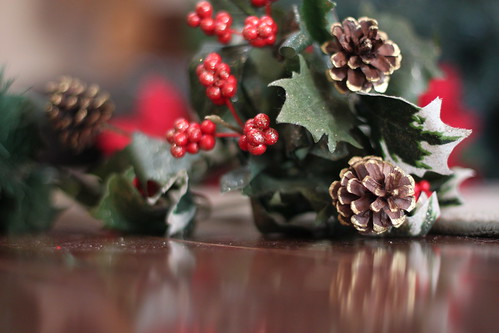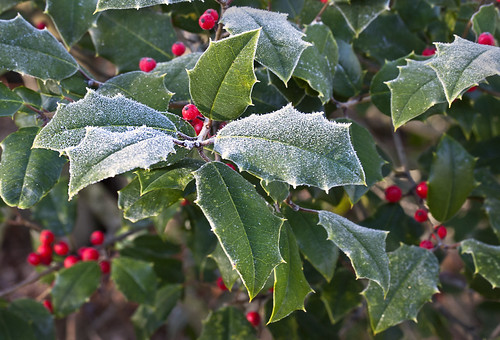Holly and Christmas are like chocolate eggs and Easter. You can’t imagine one without the other. And there’s something so delightfully festive about holly garlands or wreaths in December.

But how did this glossy but prickly plant become such a central part of Christmas decorations? Keep reading or hit play to listen to the podcast episode!
So what are the links between holly and Christmas?
As with most Christmas symbols, the link between holly and Christmas actually predates Christianity.
According to Cora Linn Daniels and C. M. Stevans, the “pupils of Zoroaster” venerated the holly tree. They believed the tree never cast a shadow (1903: 806). They also claim ancient pagans filled their temples with holly to “comfort the sylvan spirits” during winter (1903: 806).
Holly was associated with Saturn in ancient Rome. Saturn, god of both time and agriculture, gave his name to the festival of Saturnalia. Originally it was held on 17 December in the Julian calendar, but it expanded to last until 23 December.
We’ll just take a short detour because Saturnalia is just so fascinating. In short, it was a time of misrule and almost carnivalesque jovial behaviour.

Schools, businesses and legal courts closed during the festivities. People decorated their homes and spent their time singing, feasting, gambling, and giving gifts.
Saturnalia inverted social norms and masters often swapped places with their slaves. A “King of Saturnalia” might be crowned, who took charge of proceedings. Small silver objects were baked into cakes and whoever got the object in their slice became the king that day. The nature of chance fits into the chaos of Saturnalia.
This in turn perhaps explains the making of King Cake at Twelfth Night or the election of kings during Mardi Gras.
Holly as a decoration
James Napier believes the name ‘holly’ is “probably a corruption of the word holy”, referring to the plant’s associations with protecting against evil (2008: 133). He notes that Christians decked their houses with holly during Saturnalia. They weren’t joining in with the pagan feast, but rather pretending to go along with it while they quietly celebrated Christmas (2008: 133). For Napier, this is where the connection between holly and Christmas started.
In Ireland, people used holly and mistletoe as winter decorations to get the favour of the fairies (Daniels and Stevans 1903: 806). This ties in with ideas that fairies sheltered under holly leaves during winter, so they protected anyone who protected holly (Napier 2008: 133).
Mara Freeman explains that it was customary to hang a ball of holly berries and evergreens in the house before the Christmas tree gained popularity. It was “decorated with ribbons, paper roses, apples and oranges”, and may have dolls inside it to represent Joseph, Mary, and Jesus.
Protective Holly
But essentially it’s the evergreen nature of holly that makes it special – much like mistletoe. Some ancient people hung holly at their doors and windows to turn away evil spirits. Given its prickly nature, that’s not hard to believe. Daniels and Stevans note parents sprinkled water over newborns from a holly branch to deter evil spirits (1903: 806).
Some people even planted holly trees near their house, believing it protected the property from lightning strikes.
There may be some truth to this piece of lore – Paul Kendall points out that the spines on the leaves act like lightning conductors. That protects the tree and anything nearby!
According to Freeman, people thought holly protected them against witchcraft, much like the rowan tree. People might carry a staff made of holly while out walking, while a doorstep made of holly stopped witches entering your house.
Evergreen Holly
It also became a symbol of fertility. Being green all year round represented blazing eternal life. The berries also provide a food source in winter for birds (though they’re toxic to humans).

The practice of decorating with holly continued even as Britain converted to Christianity. In pagan myths, the berries signified the menstrual blood of the Goddess. When Christianity came along, they represented the blood of Christ.
In a twist of consistency typical of folklore, the protective nature of holly sits alongside its role in Christianity. Some legends claim Christ’s crucifix was made of holly wood. Others say holly formed his crown of thorns. His blood turned the berries red (Freeman).
After Christmas, boys whipped each other with holly boughs at Hogmanay to bring good luck (Freeman). Elsewhere in the country, people needed to burn Christmas holly by Twelfth Night to preserve the new year’s good luck. Other people burned it on Candlemas Eve (February 1st) since Candlemas represented Brigid and the returning light of the spring.
‘The Holly and the Ivy’
In days gone by, people believed that holly was a male plant, while ivy was a female plant. Some think the old carol, ‘The Holly and the Ivy’, actually relates to fertility myths.
Freeman explains that people often paired holly with ivy, “whose black berries symbolized night and darkness”. Here, holly was the ‘king’ and ivy was his ‘queen’.
A custom from the Midlands claimed the plant brought into the house first dictated who would rule the household that year. Holly meant the man and ivy meant the woman.
Daniels and Stevans disagree and differentiate prickly and non-prickly holly as ‘he’ and ‘she’ respectively. Bringing in a particular kind of holly for Christmas decorations dictates whether the husband or wife will “rule” in the following year (1903: 806). This custom ignores ivy completely.

Freeman also explains that burning winter greenery formed the heart of a ritual in 18th century Kent. Boys had to steal an ‘ivy girl’ from the assembled girls, while the girls stole a ‘holly boy’ from the boys. Burning these figures on a pyre became a funeral ritual to represent the death of the old year.
It was considered unlucky to bring holly or ivy into a house before Christmas Eve.
The Holly King Battles the Oak King
Within Celtic traditions, legends tell the tales of two supreme beings, fighting for supremacy. They are the Holly King and the Oak King.
Theresa Bane describes the Holly King as “the king of winter” (2013: 183). He personifies “the tenacity of life” and is shown as an old man wearing winter clothes (2013: 183). He wears a holly wreath and uses a branch of holly as a staff.
The Kings battle each other at every Solstice. At the summer solstice, the Holly King defeats the Oak King. He goes on to rule the latter half of the year, as the northern hemisphere slides into winter.

But at the winter solstice, otherwise known as Yule, the Oak King defeats the Holly King. His rule coincides with the return of spring and summer. However, there is another interpretation that the Kings do battle at the equinoxes. That makes the Oak King strongest at Midsummer, and the Holly King dominant during Yule.
So the reign of the King explains the link between holly and Christmas. The Holly King rules at that time of year!
The depictions of the Holly King seem awfully familiar. He often dresses in red and wears holly in his hair. Some images show him riding in a chariot pulled by eight stags. Who else does that sound like?!
Do you decorate with actual holly or its plastic cousin? Let me know in the comments!
References
Bane, Theresa (2013), Encyclopedia of Fairies in World Folklore and Mythology, Jefferson, NC: McFarland.
Daniels, Cora Linn, and C. M. Stevans (1903), Encyclopaedia of Superstitions, Folklore, and the Occult Sciences of the World, Vol. 2, Honolulu: University Press of the Pacific.
Freeman, Mara (no date), ‘Tree Lore: Holly’, Druidry.org, https://www.druidry.org/library/trees/tree-lore-holly. Accessed 5 December 2019.
Kendall, Paul (no date), ‘Holly mythology and folklore’, Trees for Life, https://treesforlife.org.uk/into-the-forest/trees-plants-animals/trees/holly/holly-mythology-and-folklore/. Accessed 5 December 2019.
Napier, James (2008), Western Scottish Folklore & Superstitions, Maple Shade, NJ: Leather Press.
Nutty about folklore and want more?
Add your email below and get these posts in your inbox every week.
You'll also get my 5-step guide to protecting your home using folklore!








Test
I usually go into our local woods on the Solstice and bring back holly and ivy. We don’t decorate until then anyway. I’ve the day off work tomorrow, so hope to get into the woods before dark.
Fingers crossed!
We have a friend of the family who is kind enough to make a holly wreath for all of us – he must spend ages making them for everyone.
So, real holly hangs on our door at this time of year…
Aw that’s so cool!